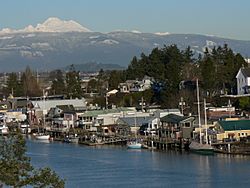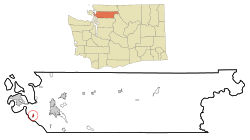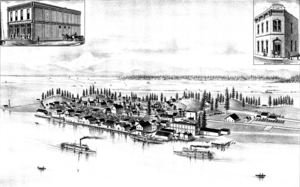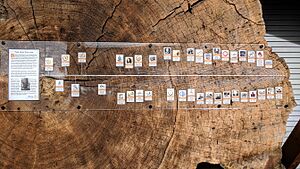La Conner, Washington facts for kids
Quick facts for kids
La Conner
|
|
|---|---|
| La Conner, Washington | |
 |
|

Location of La Conner, Washington
|
|
| Country | United States |
| State | Washington |
| County | Skagit |
| Named for | Louisa Ann Conner |
| Area | |
| • Total | 0.48 sq mi (1.25 km2) |
| • Land | 0.40 sq mi (1.03 km2) |
| • Water | 0.08 sq mi (0.22 km2) |
| Elevation | 56 ft (17 m) |
| Population
(2020)
|
|
| • Total | 965 |
| • Density | 2,384.42/sq mi (919.98/km2) |
| Time zone | UTC−8 (Pacific (PST)) |
| • Summer (DST) | UTC−7 (PDT) |
| ZIP Code |
98257
|
| Area code | 360 |
| FIPS code | 53-36780 |
| GNIS feature ID | 1534592 |
La Conner is a small and charming town in Skagit County, Washington, United States. In 2020, about 965 people lived there. It's part of the wider Mount Vernon–Anacortes area. La Conner is famous for hosting fun events during the yearly Skagit Valley Tulip Festival in April.
Contents
History of La Conner
La Conner was first settled in May 1867 by a man named Alonzo Low. Back then, it was known as Swinomish, named after its post office. Its spot on the Swinomish Channel was perfect for ships to find a safe harbor.
In 1869, J.S. Conner bought the town's trading post. A year later, in 1870, he changed the town's name to honor his wife, Louisa Ann Conner. The "La" in the name comes from her first and middle initials.
When Skagit County was formed in 1883, La Conner was chosen as the county seat, which is like the main town for government. However, it only held this title for a short time. In November 1884, the county seat moved to Mount Vernon.
In early 2020, several businesses in downtown La Conner had to close. This was mainly because they lost money when the Skagit Valley Tulip Festival was canceled.
Geography of La Conner
La Conner is located along the Swinomish Channel. This channel is right across from the Swinomish Indian Reservation on Fidalgo Island. The town is in the western part of Skagit County.
The Rainbow Bridge is a cool steel arch bridge. It connects La Conner to the Swinomish Indian Reservation. The town is north of Skagit Bay and is linked to bigger roads by local streets.
The heart of La Conner is called "the Hill." This area includes Second, Morris, and Commercial streets, and the Swinomish Channel. It's a historic district, meaning it has many old and important buildings. This district is even listed on the National Register of Historic Places.
The town covers about 0.51 square miles (1.32 square kilometers) in total. Most of this area, about 0.41 square miles (1.06 square kilometers), is land. The rest, about 0.10 square miles (0.26 square kilometers), is water.
Economy in La Conner
La Conner sits on the edge of the Skagit Valley. This valley is the biggest place in the world for growing tulips. Every April, the area hosts the famous Skagit Valley Tulip Festival. Besides tulips, farmers in the area also grow crops like potatoes, vegetable seeds, and grain.
Population of La Conner
| Historical population | |||
|---|---|---|---|
| Census | Pop. | %± | |
| 1890 | 398 | — | |
| 1900 | 564 | 41.7% | |
| 1910 | 603 | 6.9% | |
| 1920 | 516 | −14.4% | |
| 1930 | 549 | 6.4% | |
| 1940 | 624 | 13.7% | |
| 1950 | 594 | −4.8% | |
| 1960 | 638 | 7.4% | |
| 1970 | 639 | 0.2% | |
| 1980 | 633 | −0.9% | |
| 1990 | 656 | 3.6% | |
| 2000 | 761 | 16.0% | |
| 2010 | 891 | 17.1% | |
| 2020 | 965 | 8.3% | |
| U.S. Decennial Census | |||
In 2010, there were 891 people living in La Conner. There were 467 households, and 224 of them were families. The town had about 2,173 people per square mile (839 per square kilometer).
Most people in La Conner were White (87.1%). Some were Native American (5.1%), and a small number were Asian (1.0%) or African American (0.7%). About 6.2% of the population was Hispanic or Latino.
The average age in La Conner was 52.8 years old. About 16.8% of residents were under 18. Many residents were older, with 26.2% being 65 or older. The town had more females (54.9%) than males (45.1%).
Landmarks in La Conner
The Rainbow Bridge in La Conner is a famous landmark. It connects La Conner to Fidalgo Island. Fidalgo Island is home to the Shelter Bay Community, the Swinomish reservation, and the city of Anacortes.
The central part of La Conner is a historic district. This area includes streets like 2nd, Morris, and Commercial, and the Swinomish Channel. It's recognized on the National Register of Historic Places (NRHP). Another historic spot nearby is the Bethsaida Swedish Evangelical Lutheran Church Parsonage.
Notable People from La Conner
Many interesting people have lived in or have ties to La Conner.
- Tom Robbins is a well-known author who has lived in La Conner for a long time. Some parts of his books, like Another Roadside Attraction, are set in the area.
- Art Hupy (1924–2003) was a photographer from the Pacific Northwest. He moved to La Conner in 1977. He also started the Museum of Northwest Art in 1981. Many famous Northwest artists have connections to La Conner.
- Hulet M. Wells (1878–1970) was an important labor activist. He was born in a cabin near La Conner. He worked to help unemployed citizens and was a key figure in Washington's labor movement in the early 1900s.
- Joe Shell (born in La Conner in 1918) was a member of the California State Assembly. He was also a political opponent of Richard M. Nixon in 1962. His father worked with the Swinomish Reservation.
- Brian Cladoosby has been the Chairman of the Swinomish Indian Senate since 1997. He was also elected President of the National Congress of American Indians in 2013.
Education in La Conner
The town of La Conner is part of the La Conner School District. This district provides education for the children living in the area.
Arts and Culture in La Conner
La Conner is a hub for arts and culture. The Museum of Northwest Art has a permanent collection of art by Northwest artists. It also features new art shows throughout the year.
The town is also home to the Skagit Historical Museum. This museum offers great views of the town. There's also the Quilt Museum, located in the historic Gaches Mansion.
You can find several art galleries in La Conner, such as La Conner Seaside Gallery and Earthenworks. Many artists, including famous ones like Guy Anderson and Morris Graves, have worked in and around La Conner.
La Conner is also known for its many wild turkeys! In 2005, the town even named the turkey its "Official Town Bird." However, in 2006, there was a debate about whether to remove the turkeys. Some people complained about their noise and mess. By 2010, the town council decided the turkeys were a nuisance and took steps to remove them.
The La Conner public library is run by the town government. It serves residents of the local school district. The library first opened in 1993 in a former storefront. In 2012, plans were announced to build a new, permanent library. Construction began in October 2021 and finished in 2022. The new building cost $5 million and opened on October 18, 2022. It has community spaces, solar panels, and signs in English, Spanish, Braille, and Lushootseed.
Sister Cities
La Conner has special connections with other towns around the world. These are called sister cities:
 White Rock, BC, Canada
White Rock, BC, Canada Kenmare, Ireland
Kenmare, Ireland Olga, Russia
Olga, Russia San Rafael del Sur, Nicaragua
San Rafael del Sur, Nicaragua
Images for kids
-
Part of downtown La Conner, with the Swinomish Channel behind it. Rainbow Bridge at left, fishing port on the Swinomish Reservation across the channel.
See also
 In Spanish: La Conner (Washington) para niños
In Spanish: La Conner (Washington) para niños




